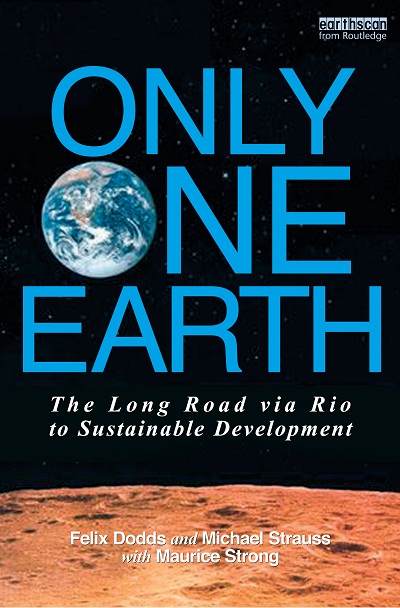Book Review- UNEP: The first forty years by Stanley Johnson
Reviewed by Derek Osborn, President, Stakeholder Forum
For the past 40 years, UNEP (the United Nations Environment Programme) has been at the centre of the global debate and international action about the environment in all its aspects. Now, in celebration and penetrating analysis of this endeavour comes a timely book “UNEP The first 40 Years” by Stanley Johnson.
 The book was commissioned by UNEP, who gladly gave Johnson access to everybody and everything he wanted to see. It is a friendly history, in the sense that Johnson is a believer in everything UNEP was set up to do, and celebrates what the institution has managed to achieve while being sympathetic to its aspirations to have done more if only circumstances had permitted. But Johnson is no pushover. UNEP was keen for the narrative to be fully independent and for Johnson to tell the story as he sees it, and he has certainly well fulfilled that brief.
The book was commissioned by UNEP, who gladly gave Johnson access to everybody and everything he wanted to see. It is a friendly history, in the sense that Johnson is a believer in everything UNEP was set up to do, and celebrates what the institution has managed to achieve while being sympathetic to its aspirations to have done more if only circumstances had permitted. But Johnson is no pushover. UNEP was keen for the narrative to be fully independent and for Johnson to tell the story as he sees it, and he has certainly well fulfilled that brief.
He describes UNEP’s key role in strengthening basic information and analysis about the state of the global environment, which resulted in the steadily more authoritative syntheses in the successive Global Environment Outlook publications. He tracks the successful negotiations for restricting the use of harmful substances such as lead and chlorofluorocarbons (CFCs), and the growing engagement of UNEP with fundamental issues about the management of the global economy, leading to the drive towards a greener, more sustainable economy.
At the same time Johnson has not balked at describing some of UNEP’s travails as well as its triumphs. He analyses the proliferation of separate environmental treaties on individual topics and the mushrooming of free-standing Conferences of the Parties to each of these, which make co-ordination so difficult. He also charts the uneasy relationship between UNEP – created at the UN Conference on the Human Environment in Stockholm in 1972 – and the UN Commission for Sustainable Development – established at the UN Conference on Environment and Development in Rio de Janeiro in 1992 – which have partially overlapping agendas.
Throughout, Johnson provides a clear view of the prime source of both strength and weakness in international bodies such as UNEP. It lies in the Member States themselves and the Governing Councils they appoint. If the Member States want action on a problem and can agree how to go about it, then everything falls into place. The five outstanding Executive Directors which UNEP has had since its founding (all still vigorously alive and active for the environment) have been powerfully effective when implementing agreed policy and action.
Life has been harder for them when they have been left as doughty but solitary champions of an issue, wrestling with apathy or disunity amongst the members, or given woefully inadequate resources to carry out the tasks assigned to them. Johnson is rightly caustic about the failure of too many of the countries of the world to follow through on their promises and commitments on the environment and their frequent failure to give UNEP the support and resources it needs to deliver results in key areas.
The book comes at a timely moment, not just to celebrate 40 years of past achievements, but at a time when – following the latest Earth Summit (Rio+20) in June 2012 – the UN General Assembly has decided to give UNEP universal membership, and to strengthen it in other important ways so that it can play an even more significant role in the next 40 years. Looking ahead, one can foresee vital roles for UNEP in helping to create the new universal Sustainable Development Goals, which Member States called for at Rio+20, and in continuing to advance the cause of the green economy, which will be the essential means of delivering those goals. As UNEP and its members grapple with these new challenges, Stanley Johnson’s book will provide many helpful lessons on how to go about the task – and also how not to.
Stanley Johnson has himself been a tireless champion of the environment for more than 40 years and has known and interacted with UNEP and its successive Directors and staff throughout that time. In lesser hands the detailed history of those 40 years and all the battles within and around UNEP could have had its longeurs. But with his own personal connections and recollections to draw upon and his novelist’s gift for organising the material into a coherent narrative illuminated with the telling phrase and lively anecdote, Johnson succeeds in bringing the story dramatically to life. We follow the twists and turns of environmental policy-making at the global level, and are left eagerly wanting to know what the next 40 years of UNEP will achieve.
When Thomas Babington Macaulay wrote his famous “History of England” he had the ambition to make it so vivid that that it would “for a few days replace the last fashionable novel on the tables of young ladies.” Whether Stanley Johnson’s “Forty Years of UNEP” will replace “Fifty Shades of Grey” on the bedside tables of today’s young ladies must perhaps be more doubtful – Tempora mutantur – but in terms of sheer readability and the importance of its subject matter it surely deserves to do so. It is certainly a worthy successor to Johnson’s own previous nine novels, and many passionate books and articles about the environment.
To purchase the book visit: www.earthprint.com


